Illinois academic R&D expenditures reach record levels
New analysis finds alignment between federal funding for academic science and technology R&D, research quality, and output in Illinois.
Download the full 2015 Spring Index.
Overview
Despite spending cuts and sequestration in recent years,[1] Illinois’ universities are capturing record levels of funding for basic, applied, and development research in science and engineering (S&E).[2] According to a new Index analysis of the most recent data from the National Science Foundation (NSF), Illinois’ universities conducted a record $2.4 billion worth of science & engineering research and development in 2013, and growth in academic R&D expenditures outpaced the nation and other leading states from 2012 to 2013.
The data also paint a picture of what makes Illinois’ university research enterprise distinctive in the race for federal funding. Like most other states, Illinois receives the majority of its academic R&D funding from the federal government. An analysis of Illinois’ average federal funding per “principal investigator” (research scientist) reveals that federal funding by this measure has also grown faster than the nation and peer states. Illinois is particularly successful in drawing funding from NSF and the U.S. Department of Energy (DOE), which tend to finance research at the frontiers of science in such disciplines as computer science and materials science.
The new analysis finds that the disciplines in which Illinois’ federal funding is most concentrated align with the research strengths and technology clusters previously highlighted in the Illinois Science and Technology Roadmap.[3] The similar conclusions from these two analyses—one of funding levels, the other of research strengths—reinforces the link between research quality and output and the federal funding a discipline receives. Thus President Obama’s recently proposed budget for science & engineering research, particularly the increases in funding to NSF and DOE, positions Illinois to increase its research leadership in disciplines important to the state’s economy such as materials science, information technology, and engineering.
Illinois university R&D funding growth bucks national trend
Unchanged from last year, Illinois remains the eighth-ranked state by amount spent on university R&D (from federal and non-federal sources). However, when adjusted for inflation,[4] Illinois’ overall expenditures grew 4.5 percent from 2012 to 2013—more than ten times faster than the nationwide increase of 0.4 percent and almost double that of the top ten states by research expenditures (not including Illinois).[5]
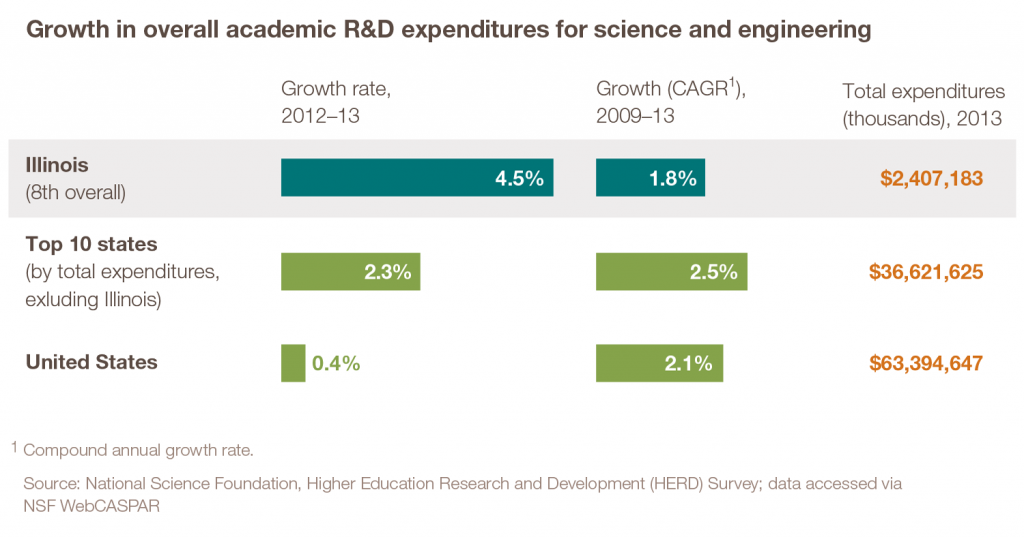
So while the federal government has made cuts to scientific research budgets, and while nationwide university R&D expenditures flatlined from 2012 to 2013, Illinois’ university research enterprise proved competitive enough to continue growing despite the difficult environment. These findings point to the exceptional strength of local research universities. The combined research expenditures of Illinois’ three largest research universities—Northwestern University, the University of Illinois at Chicago and Urbana, and the University of Chicago—account for more than three-quarters of all academic R&D expenditures. Several other universities make significant contributions to science & engineering research in the state, to the tune of more than $300 million in aggregate expenditures in 2013. This group includes the Illinois Institute of Technology, Illinois State University, Loyola University, Northern Illinois University, Rosalind Franklin University, Rush University, and Southern Illinois University.
Funding by source holds steady
As in previous years, the majority (63.9 percent) of Illinois’ university R&D expenditures came from federal funding sources in 2013. Almost a quarter (22.4 percent) came from the academic institutions themselves.
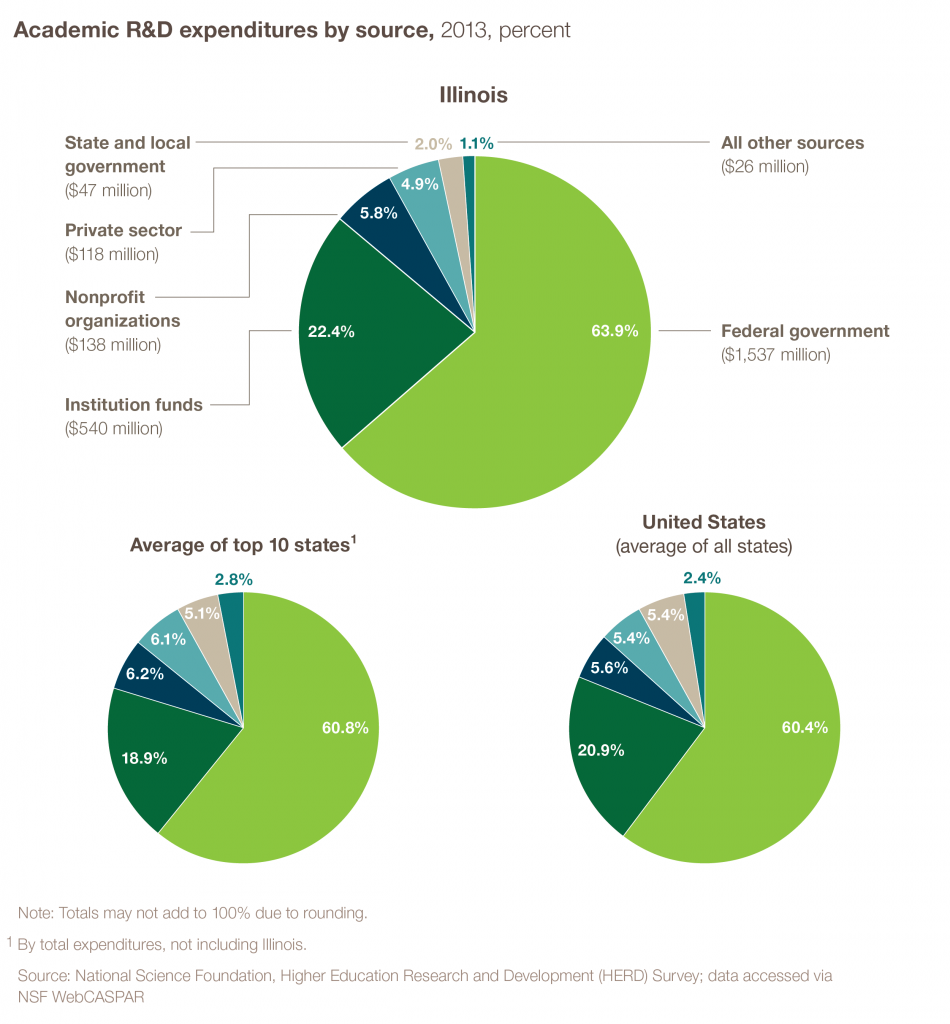
While private-sector funding accounted for a steady 4.9 percent (up slightly from 2012), those expenditures rose with the tide; private-sector funding for university R&D was $118 million in 2013, the highest it has been in the past decade. However, private-sector funding for university R&D in Illinois makes up a slightly smaller slice than the U.S. average of 5.4 percent. Among the top ten states by academic R&D expenditures (not including Illinois), the average private-sector share was 6.1 percent. This divergence suggests that Illinois’ academic research enterprise is relatively less supported by industry than in peer states—echoing recent findings by the Index of disproportionate private-sector funding for medical research in Illinois and little business funding for research in other areas where Illinois is strong, such as engineering, computer science, and physical sciences. Efforts such as the Science and Technology Roadmap, the Center for Hierarchical Materials Design (CHiMaD), and the Joint Center for Energy Storage Research (JCESR) aim to increase industry awareness of and collaboration on cutting-edge Illinois research.
R&D expenditures at Illinois’ national labs
In addition to university R&D, Illinois is also home to two university-administered national laboratories, Argonne and Fermi, both financed by DOE. The combined research expenditure of these two labs exceeded $1 billion in 2013, more than 95 percent of which came from the federal government.[6] Considered in conjunction with university research expenditures, Illinois’ research enterprise spent $3.4 billion in federal funding alone for basic, applied, and development research in 2013—the fourth highest level of federally financed science & engineering research in the country.[7] Two-thirds of Illinois’ national lab R&D expenditures go to fundamental scientific research, while applied research and development each account for approximately 17 percent of expenditures. In addition to conducting groundbreaking research, Argonne and Fermi house federally financed user facilities that provide both local and out-of-state companies with access to unique equipment and human expertise to advance innovation in areas such as biotechnology, advanced manufacturing, materials design, and big data.
Illinois’ growth in federal funding per scientist leads top states
Overall in 2013, federal grants supported the employment of more than 40,000 research scientists, post-doctoral researchers, technicians, and other individuals involved in academic R&D in Illinois. Furthermore, our analysis found that the growth in average funding per principal investigator (research scientist)—essentially a measure of funding per capita—is consistent with the overall fast growth of federal funding in Illinois.
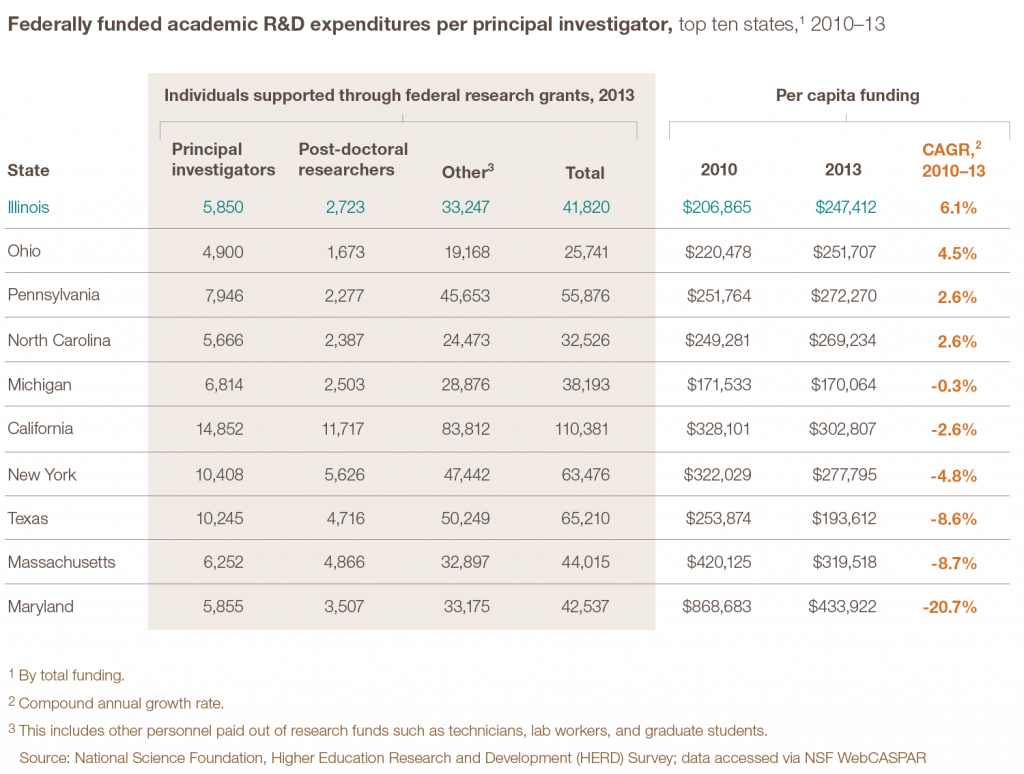
In 2013, Illinois’ 5,850 principal investigators were awarded $247,412 per capita, ranking Illinois eighth by this measure among the top ten states.[8] However, Illinois’ per capita funding growth again outperformed its peers, increasing at a CAGR of 6.1 percent from 2010[9] to 2013—the fastest of all ten states. The number of post-doctoral researchers receiving federal funding is also on the rise. Overall, the growth in per capita federal research funding indicates the success of local scientists in competing for and capturing larger research projects.
Illinois’ federally financed academic R&D is concentrated in nine disciplines
NSF data reveal that Illinois’ federally financed research is concentrated in nine disciplines—all of which the Roadmap identified as the core strengths of Illinois’ research enterprise. For example, funding for computer science research is more than three times more concentrated in Illinois compared with the national average. While medical sciences claim a third of federally financed academic R&D in Illinois, this proportion is reflected both nationwide and among the average of top states. However, its close connections with the agricultural sciences—the second-most concentrated academic R&D discipline in Illinois—is a distinctive characteristic of Illinois’ research enterprise.
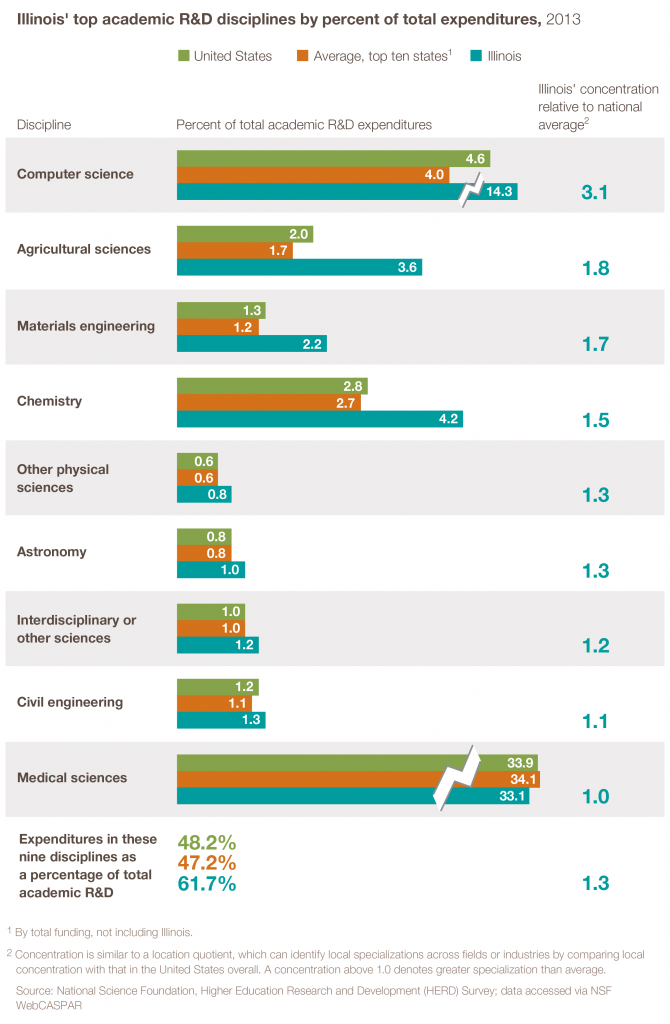
The heavy concentration of research funding in these nine disciplines—which account for more than 60 percent of Illinois’ federally financed academic R&D—reveals strengths that align with Roadmap findings of high output quality and quantity in these areas. For example, our analysis found that materials science, chemistry, and “other physical sciences”[10] were 30 to 70 percent more concentrated than the national average—consistent with the Roadmap’s findings, which identified Illinois’ core output strengths to be these same areas. Furthermore, the Roadmap found close ties between agricultural biology research and the state’s medical biotechnology and biomedical cluster. These alignments suggest a link between the level of federal funding a discipline receives and its research quality and output.
NSF and DOE are key supporters of Illinois research
Perhaps the most striking feature of Illinois’ academic research profile is the predominance of NSF and DOE funding. In 2013, NSF accounted for almost a quarter (24.3 percent) of all federally financed university R&D in Illinois, a proportion that is twice the U.S. state average. Much of this support is directed at research in computer science—the leading discipline by federal funding concentration and a clear strength of Illinois’ universities. Meanwhile DOE, a key funder of research in chemistry and materials science, contributed 6.7 percent of all academic R&D funding in Illinois, equivalent to 1.6 times the national average. Again, Illinois’ strength in materials engineering, chemistry, and physics research attract this financing.
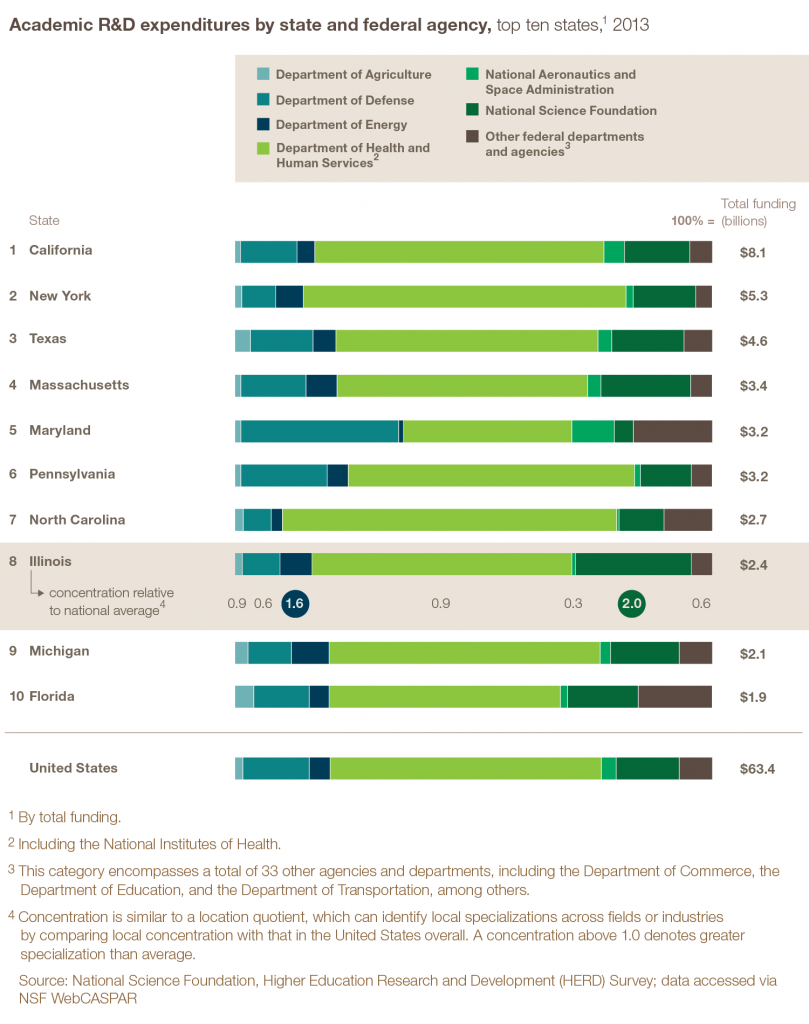
By volume, the Department of Health and Human Services (HHS), which includes the National Institutes of Health (NIH), is the largest financer of research in most leading states. In Illinois, HHS accounted for 54.5 percent, or $838 million, of federally supported academic R&D expenditures in 2013. HHS funding typically supports medical and biological research. When compared with the national average, Illinois receives a significantly lower portion of its funding from the Department of Defense (DOD)—just 7.9 percent compared with 13.9 percent nationally.
Looking forward
In light of the present analysis, the recently proposed federal budget holds important clues to opportunities for Illinois’ academic research enterprise. President Obama’s proposed FY2016 budgetenvisions $146 billion for science & engineering programs spread over 20 agencies.[11] The budgets of NSF and DOE—the two agencies most strongly aligned with Illinois’ university research enterprise—will see their combined funding increase by $700 million. A concerted effort to ensure appropriations that are commensurate with the proposed budget for these agencies will likely provide significant benefits for Illinois. In addition, the budget designates a total of $2.4 billion for advanced manufacturing and increases the NIH budget by $1 billion. With more than 50 percent of federally financed research in Illinois coming from NIH and a developing advanced manufacturing infrastructure in the state, federal approval could bring more years of record R&D funding to Illinois.
Hourihan, Matt, “A primer on recent trends in federal R&D budgets,” American Association for the Advancement of Science (AAAS), January 15, 2015.
All academic R&D discussed in this issue refers specifically to that in science & engineering fields. Our analysis excluded expenditures on research in the humanities, law, and business/management.
The Illinois Science and Technology Roadmap was released by the ISTC in September 2014 to inform and guide the State of Illinois’ technology-based economic development efforts.
The NSF currently adjusts historical data to 2009 as the base year. In real terms, from 2009 to 2013 federal funding for university R&D actually fell by 3.1 percent, while Illinois’ total increased by 2.1 percent.
These ten states account for more than half of all academic R&D expenditures in the United States.
According to the latest available data, reported in the NSF FFRDC Research and Development Survey, FY 2012.
Illinois’ total (university and national laboratory) federally financed R&D expenditures are exceeded only by California, New York, and Maryland.
Top ten both by federal funding for academic R&D and number of university researchers.
The oldest available NSF data on this metric goes back to 2010.
This category is used for multidisciplinary or interdisciplinary projects that cannot be classified within one of the broad fields of science already listed such as astronomy, chemistry, or physics.
Archive
2022 - R&D Index
Illinois' R&D Landscape and How COVID-19 Impacted Innovation
2020- R&D Index
Illinois' Capacity for Innovation & Economic Growth
2019 - R&D Index
Illinois' R&D Landscape & Path Forward
2018 - R&D Index
R&D growth struggles to match peer states, but machinery, finance & insurance among bright spots.
2017 - R&D Index
New analysis finds slow R&D growth in Illinois, despite key academic and business areas of strength.
2015 - R&D Index
Analysis finds alignment between federal funding for academic science and technology R&D, research quality, and output in Illinois.
2014 - R&D Index
R&D expenditures by Illinois universities hold steady
2013 - R&D Index
Capital and infrastructure for innovation
